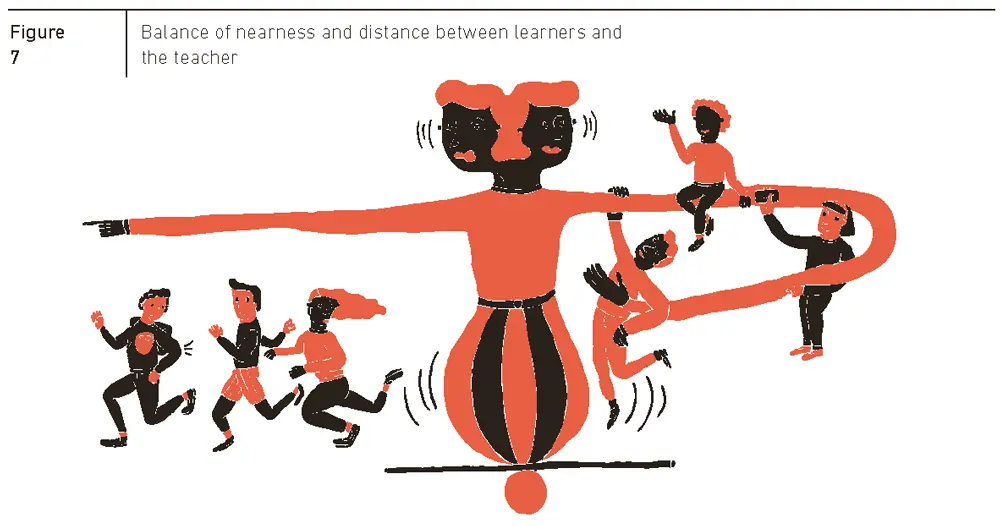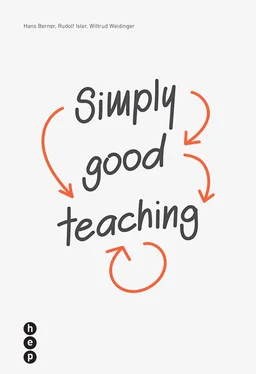Side note: Learning objectives and competences
Learning objectives
The learning objective-oriented or curricular didactics, developed by Christine Möller, has been of great importance for teacher education for four decades and strongly influences instructional practice. It demands that establishing educational goals, selecting objectives and, particularly, formulating learning objectives must play a key role in lesson planning.
According to the learning objective-oriented didactics15, correctly defined goals are essential if students’ learning is to be led into the prescribed direction of the school’s educational mission and educational mandate. The goals must be simultaneously challenging and attainable. They should be justified and transparent for all those involved in the educational enterprise. However, balanced goal settings may not just limit themselves to the attainment of certain standards in school subjects but must also concern interdisciplinary, personal, and social aspects. Only when the sharing of learning strategies, the promotion of self-efficacy or the encouragement for collaboration are formulated as objectives can we expect that instructional efforts indeed follow in a common systematic pursuit of that goal. A learning objective-oriented didactics that demands special observation of learning objectives rejects randomness, arbitrariness, and aimlessness in the classroom.
The demands of curricular didactics are by no means an isolated case. Other general didactic theories emphasize the central importance of learning objectives as well. Of particular note is Wolfgang Klafki. With his classic postulate of categorical training (Postulat der kategorialen Bildung)16 he took the view that good teaching must distinguish itself by a balanced combination of materialistic (content-related) and formal goals (related to the development of the person). In summary, it can be said that the focus on the setting and formulating of learning objectives follows a long pedagogical tradition, which has remained current up to the present, with a strong influence on teacher education, and which retains a prominent place among the tools for lesson planning (see chapter 9).
Competences
At the beginning of the 21 st century, the concept of learning objectives retreated somewhat into the background of the school education discussions at the expense of the increasingly more dominant concepts of competence. In the course of large empirical school achievement studies and in conjunction with standardization efforts, the concept of competence became a trend term and slogan for education reform and education policy.
Competence is an ambiguous term with a complex history. The term was originally used in linguistics by Noam Chomsky in reference to the knowledge which a speaker or listener has of his or her language. In contrast, Chomsky described the actualization of this knowledge in the act of speaking as performance, which finally rendered more apparent to him what is only latently present in competence. For Heinrich Roth, who introduced the concept of competence into pedagogy, subject competence, self-competence and social competence only conditionally include a performance aspect; however, they form the pre-conditions for self-determination, which is the central educational objective for Roth.
In the last twenty years, a concept of competence has prevailed and established itself in educational science which clearly includes this performance aspect and is mostly used in references to formulations by Franz E. Weinert and Eckhard Klieme. Weinert describes competence as “an individual’s inherently available or learnable cognitive capabilities and skills to solve certain problems, as well as the related motivational, volitional and social readiness and skills to apply problem solutions in variable situations successfully and responsibly.”17 Klieme considers competence in relation to educational standards and concludes “that educational standards – other than curricula and framework guidelines – do not fall back on syllabi and lists of learning content to substantiate educational objectives. Competences reflect the fundamental action requirements to which students are exposed in this domain.”18 These definitions clearly expose the trajectory of the current competence movement: it is a question of “dead knowledge” and “how one can get others (or oneself) to effectively apply concepts, ideas, or indeed knowledge, and put them into practical action …”19.
In summary, it can be said that the term competence currently references what Chomsky described as performance in linguistics, namely the ability to master situationally-influenced challenges, or, in other words, to perform actions that are visible and measurable. Thus, the concept of competence complies with the current educational reform whereby the performance of the school is not directed through input, “but – just as in a business enterprise – is to be measured using the actual realized learning gains, the output.”20

These implementation instructions are presented in the same sequence as in the previous section. If the characteristics are followed up again in the following chapters or we view a characteristic as unimportant, we will limit ourselves to just a few important notes.
1 Create a learning-conducive climate
When it comes to creating a learning-conducive climate in the classroom, it should suffice to observe the formulated rules on page 26. This is easier said than done, however, as the instructor’s personality with his/her ways of establishing contact with the students is central to this characteristic. This ability is not mastered as a technique but is rather an expression of attitudes and possibilities that are at the disposal of a teacher for relationship building.
If an instructor would like to work on optimizing a learning-conducive climate, it would mean, for one, that s/he would realize the pedagogical-didactic suggestions put forth in this book, such as applying the principle of positive reciprocal affects at the beginning of a lesson (see chapter 2, p. 63). Furthermore, it is certainly always a matter of finding an age-appropriate balance between nearness and distance to the learners and a considered mixture between a working atmosphere and personal contact.

On the other hand, a critical analysis of one’s own approaches and possibilities in relationship building is advisable. For one, this can occur by studying the applicable literature . The recommendations by the humanistic psychologist Carl Rogers of 50 years ago are still well worth reading. His postulated attitudes – respect, warmth, consideration; empathetic, non-judgmental understanding; genuineness; minimal direction and guidance – are significant in pedagogical contexts as well. This may also occur in discussions and exchanges with teacher colleagues , such as discussions and intervention groups, which offer a greater awareness of one’s approaches and relationships patterns, and promote their further development.
2 Classroom management can be learned – it is not just an expression of a certain talent
Nolting’s previously referenced publication relates to Kounin’s Techniques of classroom management 21. Among his suggestions for classroom management, we consider the following most significant:
Omnipresence (with-it-ness)
The students should have the impression that their teacher keeps an open eye and ear on all their activities, so that disruptive incidents are not consciously “overlooked” and difficult problems are not tolerated.
Читать дальше














